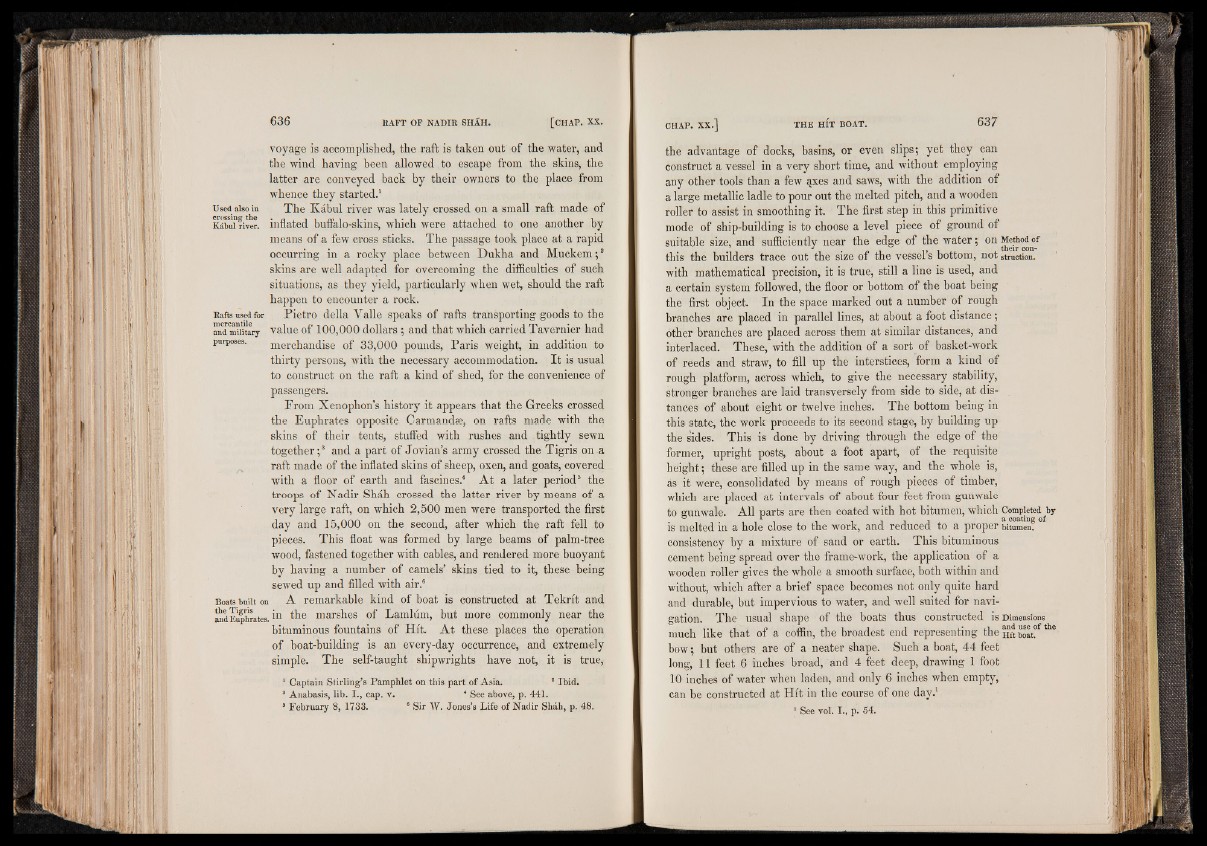
voyage is accomplished, the raft is taken out of the water, and
the wind having been allowed to escape from the skins, the
latter are conveyed back by their owners to the place from
whence they started.1
Used also in The Kabul river was lately crossed on a small raft made of
Kabul river. inflated buffalo-skins, which were attached to one another by
means of a few cross sticks. The passage took place at a rapid
occurring in a rocky place between Dukha and Muckem;2
skins are well adapted for overcoming the difficulties of such
situations, as they yield, particularly when wet, should the raft
happen to encounter a rock.
Bafts used for Pietro della Valle speaks of rafts transporting goods to the
and military value of 100,000 dollars ; and that which carried Tavernier had
purposes. merchandise of 33,000 pounds, Paris weight, in addition to
thirty persons, with the necessary accommodation. It is usual
to construct on the raft a kind of shed, for the convenience of
passengers.
From Xenophon’s history it appears that the Greeks crossed
the Euphrates opposite Carmandse, on rafts made with the
skins of their tents, stuffed with rushes and tightly sewn
together;3 and a part of Jovian’s army crossed the Tigris on a
raft made of the inflated skins of sheep, oxen, and goats, covered
with a floor of earth and fascines.4 At a later period5 the
troops of Nadir Shah crossed the latter river by means of a
very large raft, on which 2,500 men were transported the first
day and 15,000 on the second, after which the raft fell to
pieces. This float was formed by large beams of palm-tree
wood, fastened together with cables, and rendered more buoyant
by having a number of camels’ skins tied to it, these being
sewed up and filled with air.6
Boats built on A remarkable kind of boat is constructed at Tekrit and
and Euphrates la the marshes of Lamlum, but more commonly near the
bituminous fountains of Hit. At these places the operation
of boat-building is an every-day occurrence, and extremely
simple. The self-taught shipwrights have not, it is true,
1 Captain Stirling’s Pamphlet on this part of Asia. ! Ibid.
8 Anabasis, lib. I ., cap. v. 4 See above, p. 441.
5 February 8, 1733. ' Sir W . Jones’s Life of Nadir Shah, p. 48.
the advantage of docks, basins, or even slips; yet they can
construct a vessel in a very short time, and without employing
any other tools than a few ijxes and saws, with the addition of
a large metallic ladle to pour out the melted pitch, and a wooden
roller to assist in smoothing it. The first step in this primitive
mode of ship-building is to choose a level piece of ground of
suitable size, and sufficiently near the edge of the water; on Method of . this the builders trace out t■h. e si• ze of the vesseul si baoatt om, not their con- struction.
with mathematical precision, it is true, still a line is used, and
a certain system followed, the floor or bottom of the boat being
the first object. In the space marked out a number of rough
branches are placed in parallel lines, at about a foot distance;
other branches are placed across them at similar distances, and
interlaced. These, with the addition of a sort of basket-work
of reeds and straw, to fill up the interstices, form a kind of
rough platform, across which, to give the necessary stability,
stronger branches are laid transversely from side to side, at dis- _
tances of about eight or twelve inches. The bottom being in
this state, the work proceeds to its second stage, by building up
the sides. This is done by driving through the edge of the
former, upright posts, about a foot apart, of the requisite
height; these are filled up in the same way, and the whole is,
as it were, consolidated by means of rough pieces of timber,
which are placed at intervals of about four feet from gunwale
to gunwale. All parts are then coated with hot bitumen, which Completed by is melted in a hole1 close to the wor.k , and- ire-diuc- eidj t o a proper a coating of bitumen,
consistency by a mixture of sand or earth. This bituminous
cement being spread over the frame-work, the application of a
wooden roller gives the whole a smooth surface, both within and
without, which after a brief space becomes not only quite hard
and durable, but impervious to water, and well suited for navigation.
The usual shape of the boats thus constructed is Dimensions
much like that of a coffin, the broadest end representing the h b boat? 8
bow; but others are of a neater shape. Such a boat, 44 feet
long, 11 feet 6 inches broad, and 4 feet deep, drawing 1 foot
10 inches of water when laden, and only 6 inches when empty,
can be constructed at Hit in the course of one day.1
1 See vol. I., p. 54.